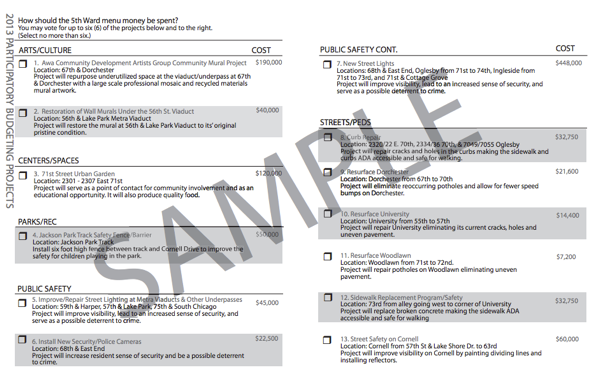Participatory budgeting keeps up its slow spread across the U.S., with Chicago this month wrapping up a vote in four of its wards to determine how to divvy up more than $4 million in infrastructure funds. Since 2009, the city’s 49th ward has decided by ballot how to spend some of its alderman’s discretionary “menu money.” This year, it was joined by the 5th, 45th and 46th wards.
Rough results are in for the vote that took place earlier this month, timed to coincide with the Second International Conference on Participatory Budgeting in the U.S. and Canada. Thea Crum, of the Great Cities Institute at University of Illinois at Chicago Crum shared what she found both encouraging and surprising about the results
Turnout in the new wards came in at about 1 percent — not much, perhaps, but on par with New York City’s recent, better-publicized PB vote. Participation was much higher in the 49th ward, which in addition to its history of community budgeting enjoyed highly visible mobile voter stations. “It takes time to filter through the population,” Crum said.
Indeed, despite the fact that PB has been done in Brazil since 1989, it’s still a fairly novel idea in the United States. Only Chicago, New York and the California city of Vallejo have gone through the full PB process, where locals come up with ideas and vet them with experts before putting them on the ballot. In March Boston announced a limited experiment with PB, setting aside $1 million for the city’s young people to vote on. (In Chicago, residents as young as 16 years old were eligible to participate in the vote.)

Sample participatory budgeting ballot.
Low turnout, goes an oft-heard critique of PB, puts the process at risk of being co-opted. But this calls for some perspective: The pool of Chicagoans determining how $4 million gets spent went from four alderman last year to 2,600 engaged citizens this year.
As an exercise in democratic participation, PB has been praised for presenting citizens with tangible, easy-to-understand projects. Still, citizen education is key. Surveys of the two dozen or so neighborhood assemblies held during the eight-month lead-up to the vote found that 41 percent of attendees said that they went in understanding “Aldermanic Menu Money,” while 82 percent came out with a handle on the concept. There was “a bit of sticker shock” about the cost of infrastructure projects, Crum said. “A million dollars doesn’t go as far as you think.”
But there were some surprises for organizers, too. Streets and streetlights were big winners, as was a $120,000 project for new paint and pigeon netting for neighborhood underpasses. But Crum pointed out that, amid the heated political debate around surveillance, voters in both the 5th and 46th wards chose to dedicate a combined $70,500 to new police cameras.
Vallejo, a Bay Area city of 116,000, is voting right now on how to spend $3 million it has collected from a local sales tax.

Nancy Scola is a Washington, DC-based journalist whose work tends to focus on the intersections of technology, politics, and public policy. Shortly after returning from Havana she started as a tech reporter at POLITICO.
















